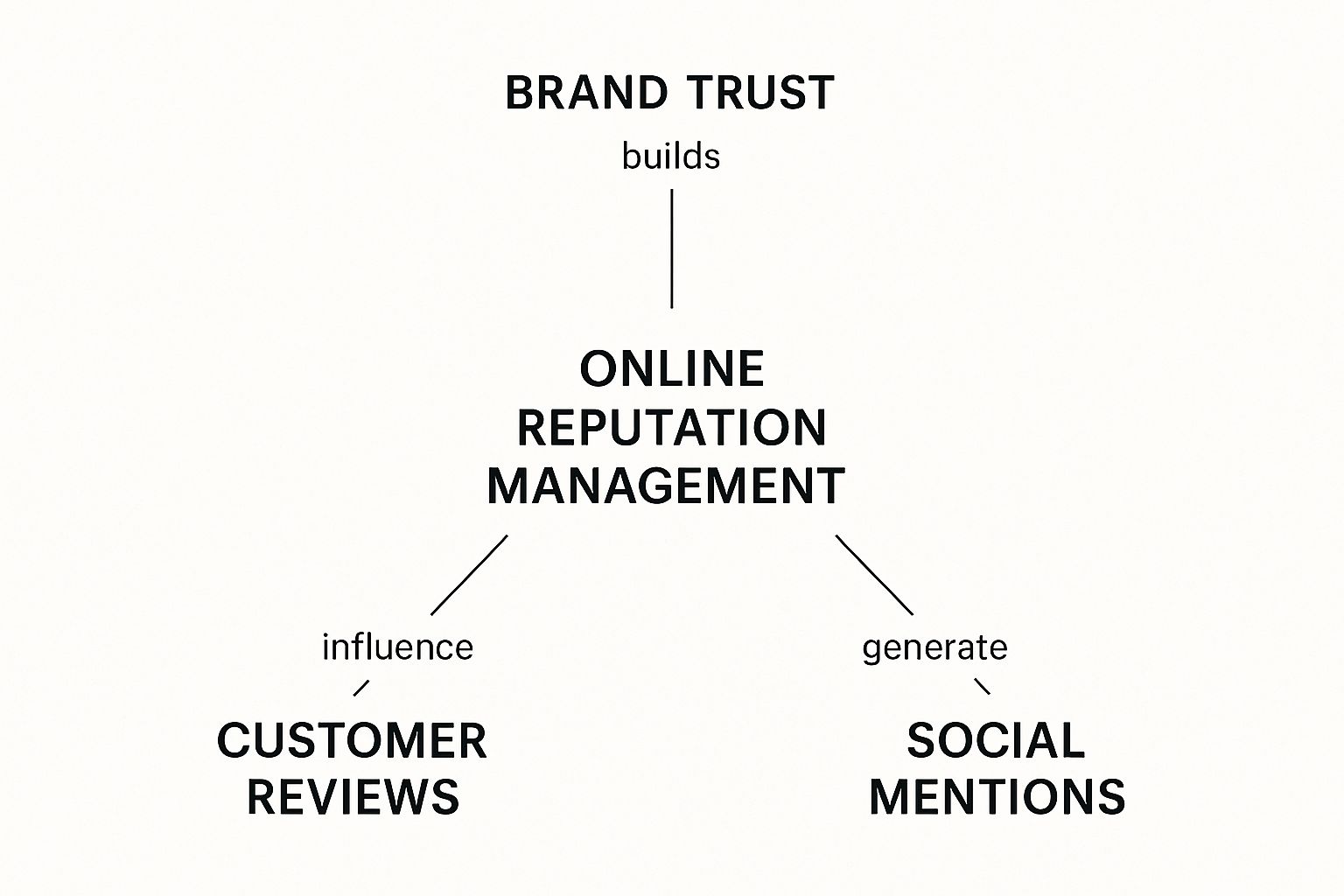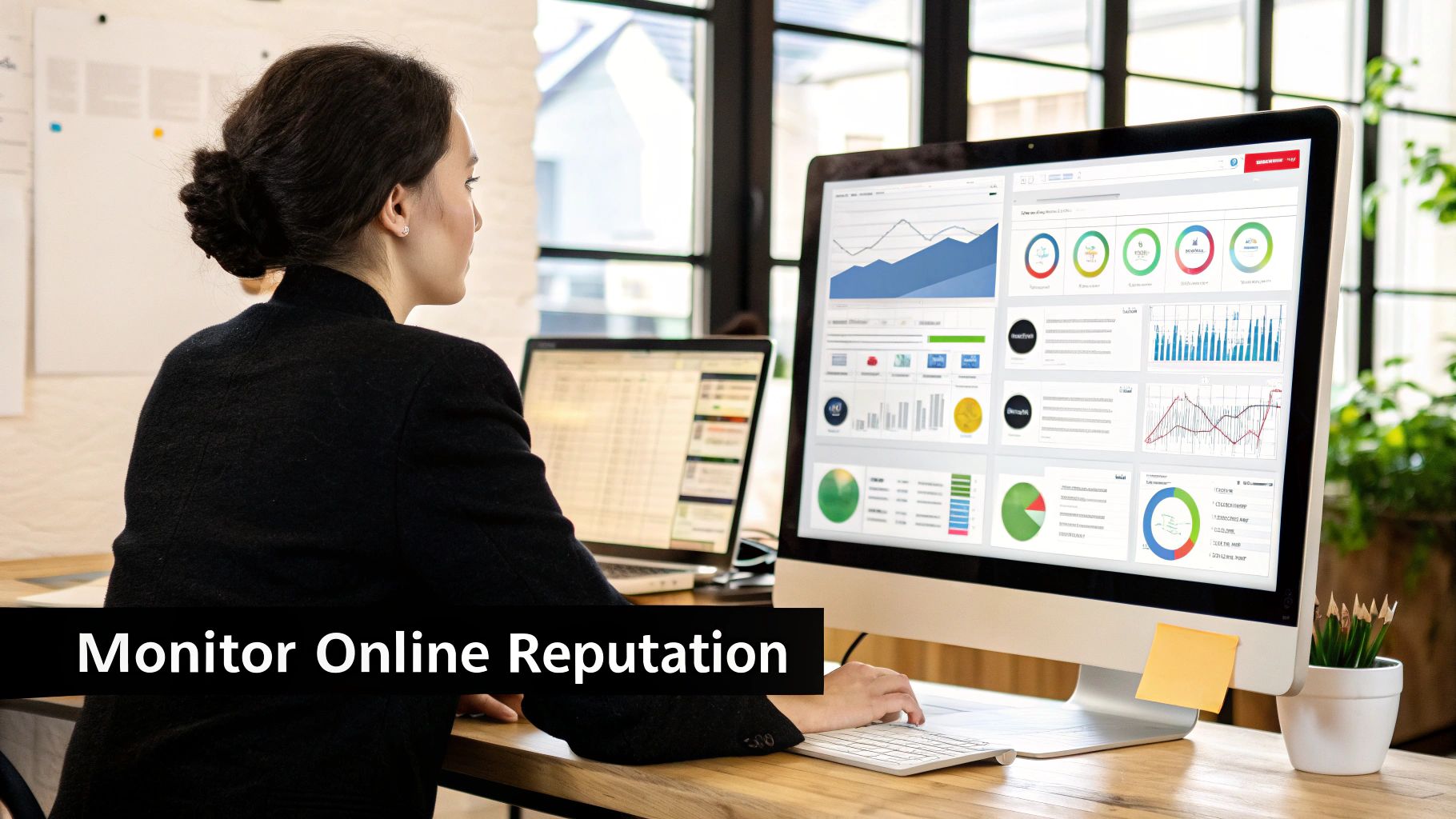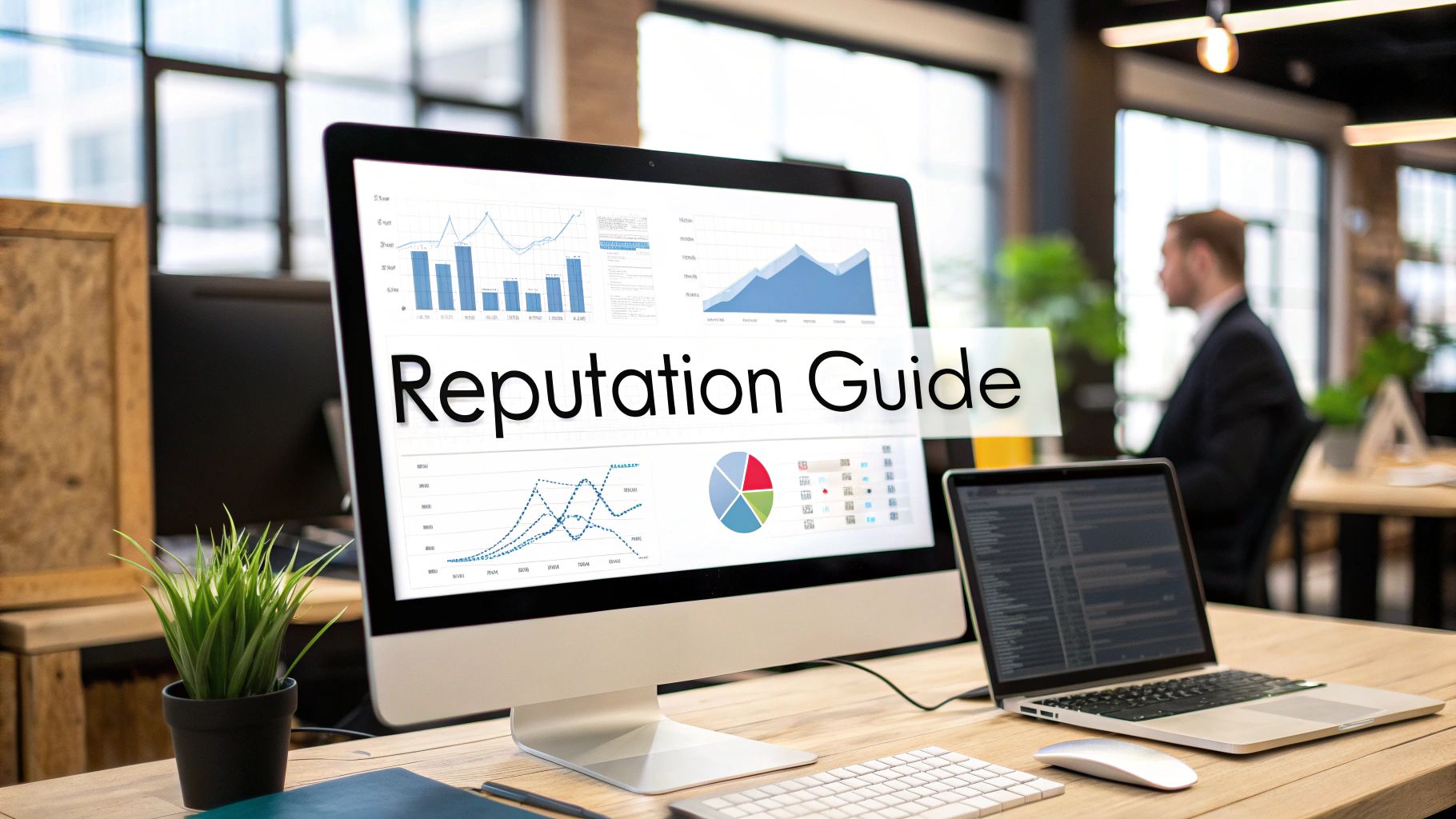An online reputation management guide is your playbook for monitoring, influencing, and ultimately controlling your brand's story online. It’s the process of actively shaping what people see and think, from reviews and social media chatter to what pops up on the first page of Google.
Why Your Online Reputation Is a Core Business Asset
Think of your online reputation less like a fuzzy marketing metric and more like your company’s digital credit score. It’s built slowly, can be wrecked in a heartbeat, and it’s the first thing prospects, partners, and even potential hires look at before they decide to engage with you.
This isn’t just about perception; it’s a tangible asset that has a very real impact on your bottom line.
In the B2B SaaS world, trust is everything. Your buyers are doing 90% of their research before they ever talk to a sales rep. What they find—or don't find—on that first page of Google can make or break a deal before it even starts.
The High Stakes of Digital Perception
One negative article, a string of bad reviews on a site like G2, or a single poorly handled Twitter comment can derail an entire sales cycle. It plants a tiny seed of doubt that’s incredibly hard to pull out, no matter how slick your product demo is. The numbers don't lie: a huge chunk of potential customers will simply walk away after seeing something negative.
Just think about these all-too-common scenarios for a SaaS company:
- The Derailled Deal: A hot enterprise lead is just about to sign. As a final check, the CFO Googles "[Your Company Name] reviews" and the top result is a detailed blog post about a customer's nightmare onboarding experience. Suddenly, the deal goes cold.
- The Recruitment Roadblock: Your top engineering candidate is thrilled with your offer. But then they check Glassdoor and see a few reviews mentioning a "toxic culture." They politely decline and accept an offer from your competitor.
- The Partnership Pause: You're trying to lock down a crucial integration partner. They do their due diligence, find a bunch of mixed sentiment on social media, and start to question your stability and customer support. The conversation stalls.
Your online reputation is the silent influencer in every room. It’s the invisible force that can either accelerate your growth or act as a constant headwind, making every single sale, hire, and partnership that much harder and more expensive to win.
More Than Just Damage Control
This is exactly why you need a real online reputation management guide. This isn’t about playing defense and just reacting when something bad happens. It’s about proactively building a fortress of positive content around your brand.
It’s about encouraging happy customers to leave reviews, publishing genuinely helpful thought leadership, and showing up in the right online communities.
When you take control of the narrative, you create a powerful buffer against inevitable threats. A solid foundation of trust means that when a negative comment does surface, it looks like an outlier, not the norm. At the end of the day, managing your online reputation is a core business function—just as critical to your survival and growth as sales or product development.
The Four Pillars of an Effective ORM Strategy
To really get a handle on your online reputation, you need more than just good intentions. You need a framework that turns vague goals into a concrete plan. A solid online reputation management strategy is built on four pillars that work together: Monitoring, Responding, Building, and Protecting.
Think of your brand’s digital presence like a public garden. You can't just show up when there's a problem—you need a consistent routine to keep it healthy. This four-pillar approach is that routine, making sure nothing gets missed.
Pillar 1: Monitoring Your Digital Footprint
The first pillar is Monitoring. This is your daily walk through the garden. You can’t fix problems you don't even know exist. This step is all about setting up a system to listen for any mention of your brand, your executives, and your products across the web.
And this isn't just about checking Twitter. Real monitoring goes much deeper:
- Review Sites: For B2B SaaS, platforms like G2, Capterra, and TrustRadius are everything. One bad review can kill a deal right before a demo.
- Social Media: This means tracking conversations on LinkedIn, Reddit, and other forums where people in your industry actually hang out.
- Forums and Communities: This is where the real, unfiltered opinions live. Niche forums and private Slack groups are gold mines for honest feedback.
- Search Engine Results: Keeping an eye on the first page of Google for your brand name is non-negotiable.
Good monitoring is your early warning system. It helps you spot the smoke before it becomes a full-blown crisis, buying you precious time to act.
Without this, you’re flying blind. You’re letting other people control your brand’s story, and that’s a risk no SaaS company can afford.
This infographic lays out the critical link between brand trust, customer reviews, and social mentions—all the key signals you need to be watching.

As you can see, each piece directly impacts the others. It creates a feedback loop where good reviews build trust, and positive social chatter amplifies it.
Pillar 2: Responding with Purpose
Once you spot a mention, the second pillar, Responding, kicks in. This is about tending to what you found in the garden—pulling the weeds, nurturing the good stuff. How you respond often matters more than the original comment itself.
A fast, empathetic, and professional reply can flip a negative situation into a moment that actually builds trust. In fact, research shows that 89% of consumers are more likely to buy from a company that responds to all of its online reviews. It proves you're listening and that you care.
On the flip side, silence looks a lot like guilt or indifference.
Pillar 3: Building a Positive Narrative
The third pillar is Building. This is where you shift from defense to offense. Instead of just pulling weeds, you’re actively planting flowers and strong trees that will define your garden’s landscape.
This is all about creating and promoting content that builds a "digital fortress" of positive, brand-owned assets. It includes things like:
- Encouraging Positive Reviews: Building a system to ask your happiest customers for feedback on the review sites that matter.
- Creating Thought Leadership: Publishing valuable blog posts, whitepapers, and case studies that establish your company as an authority.
- Securing Positive Media: Earning mentions and features in well-respected industry publications.
When you do this right, anyone searching for your brand will find a ton of credible, positive information that you planted yourself.
Pillar 4: Protecting Your Brand Equity
Finally, we have the fourth pillar: Protecting. This is the fence you build around your garden to keep future threats out. It’s about strengthening your online assets to make it harder for negative content to show up high in search results.
This is where reputation management and SEO become best friends.
By optimizing your owned properties—your website, blog, LinkedIn page, and other social profiles—you can dominate the first page of Google for your brand name.
When you control those top spots, you create a powerful buffer. Any negative press or bad reviews get pushed down to page two or beyond, where almost no one will ever see them. Protection is the long game that secures the value of all your other ORM work.
How Digital Perception Tanks Your Bottom Line
Your online reputation isn't a vanity metric—it's a direct lever on your revenue. What potential customers find when they Google your brand can either fill your sales pipeline or quietly drain it, often without you ever knowing why a hot lead suddenly went cold.

Think of Google's first page as your digital storefront. Every search result is a window display. If the first few windows show glowing reviews and helpful content, prospects are eager to come inside. But if they see critical articles or bad press, most will just keep walking.
This isn't just a theory; the financial impact is real and quantifiable. Every negative search result that ranks for your brand name is actively working against your sales team, making their job harder and more expensive.
The Financial Cost of a Bad First Impression
The damage from a poor online reputation multiplies fast. Recent data shows that just two negative search results on the first page can cause a business to lose up to 44% of potential customers. With three negative listings, that number jumps to a staggering 59%. You can dig deeper into how reputation sways buyers on TheBestReputation.com.
Let's put this into a real-world B2B SaaS scenario. Say your marketing team generates 100 high-quality leads this month. If a couple of negative reviews are sitting on page one of Google, you could lose 44 of those leads before your sales reps even get a chance to send their first email.
This creates a domino effect of problems:
- Skyrocketing Customer Acquisition Cost (CAC): You're forced to spend more on marketing just to replace the leads you're losing to bad search results.
- Longer Sales Cycles: The leads who do engage are already skeptical. Your sales team has to spend extra time and energy overcoming objections and rebuilding trust that was broken by a single search.
- Plummeting Conversion Rates: Doubt is a powerful deal-killer. Even with a stellar product, a damaged reputation can torpedo your demo-to-close ratio. You can learn more about tracking these vital content marketing metrics in our guide.
Framing ORM as a Growth Driver, Not a Cost Center
Because of these direct financial ties, it’s a huge mistake to see online reputation management as just another expense. It’s not about "cleaning up" messes after the fact; it's a core strategy for protecting and growing your revenue.
A proactive ORM strategy is an investment in your sales and marketing efficiency. By controlling your brand's narrative online, you reduce friction in the buyer's journey, shorten sales cycles, and lower your cost to acquire each new customer.
When you invest in a strong digital reputation, you ensure that when potential buyers do their homework, they find compelling reasons to trust you—not reasons to back out. That makes the business case for ORM undeniable. It’s a powerful driver of customer acquisition, retention, and long-term, sustainable growth.
How to Build Your Proactive ORM Action Plan

A proactive approach to reputation management is the difference between steering your brand’s narrative and being a passenger in a story someone else is writing. It’s not about waiting for a crisis to hit. It’s about building a repeatable system that strengthens your reputation, day in and day out.
So, let's get practical. A solid ORM action plan breaks down into four key phases: running a full audit, setting up your digital watchtowers, creating a response protocol, and building a content fortress to secure your online presence.
Conduct a Comprehensive Digital Audit
Before you can move forward, you need to know exactly where you stand. Think of a digital audit as a full diagnostic scan of your brand's online health. It gives you a clear baseline, showing you exactly where you’re strong and where you’re vulnerable.
Your audit needs to be systematic. Cover every digital corner where your brand exists.
- SERP Analysis: Google your brand name, key products, and the names of your executives. What shows up on the first two pages? Document everything and tag it as positive, negative, or neutral.
- Review Site Deep Dive: Don’t just glance at the star rating. Dig into the big B2B SaaS review sites like G2, Capterra, and TrustRadius. What are the common themes popping up in both the good and bad reviews?
- Social Media Scan: Check LinkedIn, X (formerly Twitter), and industry forums or Reddit communities. What’s the general vibe? Are there unanswered complaints festering or glowing testimonials you’ve completely missed?
This audit is the raw data that will fuel your entire strategy. It tells you exactly where to focus first to get the biggest impact.
Set Up Automated Monitoring Systems
Once the audit is done, you can’t afford to fly blind again. Automated monitoring is your 24/7 digital watchtower, pinging you in real-time the moment your brand gets mentioned. This lets you get ahead of the conversation instead of just reacting to it days later.
Proactive monitoring turns reputation management from a stressful, reactive firefight into a controlled, strategic part of your business. It’s the early warning system that stops small sparks from becoming raging infernos.
Setting up your system is pretty straightforward:
- Choose Your Tools: Pick a monitoring tool that fits your needs. Brand24 or Mention are great, but even Google Alerts is a good place to start for free. You need something that tracks keywords across social media, news sites, and blogs.
- Define Your Keywords: Go beyond just your company name. Track product names, executive names, common misspellings of your brand, and even your top competitors to get a feel for the wider industry chatter.
- Configure Your Alerts: Set up email or Slack notifications for new mentions. Most tools let you filter by sentiment (positive, negative, neutral) so you can jump on the urgent stuff immediately.
Create a Clear Response Matrix
Knowing someone mentioned you is only half the battle. Knowing exactly how to respond is what separates the pros from the amateurs. A response matrix is a simple but powerful document that maps out who responds, to what, and how. It kills the guesswork when things get tense and keeps your brand voice consistent.
Think of it as your internal playbook for every type of online interaction. A good framework ensures every bit of feedback gets a timely, on-brand response, turning potential fires into opportunities to show you care.
ORM Response Matrix Framework
This isn't just about damage control; it's about building relationships and proving your company's values in public.
Build Your Digital Fortress with Content
Ultimately, the best proactive strategy is to own your search results. This means building a "digital fortress" of high-quality, brand-owned content that pushes everything else down the page. When you control what people find when they Google you, you control the narrative. This is where solid B2B social media marketing strategies come in to help spread your message.
Your content plan should be all about creating a portfolio of positive assets. Publish insightful articles on your blog, land guest posts on respected industry sites, and create genuinely useful case studies. The goal is to build so much positive authority that any negative hit gets buried on page three, where it becomes almost invisible.
The Modern Toolkit for Reputation Management
A solid reputation management strategy is more than just a plan—it needs the right tech to actually work. Trying to manually track every mention, review, and search result is a surefire way to get overwhelmed. This is where a dedicated tech stack comes in, acting as your eyes and ears across the digital world.
Picking the right software isn't just about being efficient; it’s about getting a real competitive edge. The market for these tools is exploding as businesses wake up to their importance. In fact, the ORM software industry was valued at roughly $5.2 billion in 2024 and is expected to nearly triple to $14.02 billion by 2031. You can dig into more of these stats over on ReputationX.
That kind of growth sends a clear message to B2B SaaS companies: investing in the right tools is no longer a "nice-to-have." Let’s break down the three core types of software that make up a modern ORM toolkit.
Social Listening and Monitoring Tools
First up, and arguably the most fundamental, is social listening software. Think of these tools as your digital radar, constantly scanning the web for mentions of your brand, your products, and even your key executives. They pick up conversations happening everywhere from social media to forums like Reddit and news sites.
Without them, you're flying completely blind, only finding out about problems after they've already blown up.
- What They Do: These platforms track keywords in real-time, giving you a pulse on public sentiment, letting you spot trends as they emerge, and helping you jump into conversations with your audience.
- Top Examples: Tools like Brand24 and Mention are popular for a reason, offering powerful analytics and instant alerts.
- Key Features: Look for sentiment analysis—it’s a lifesaver for quickly sorting mentions into positive, negative, or neutral buckets. You also want broad platform coverage to make sure you’re not missing chatter in some forgotten corner of the internet.
Review Management Platforms
For any SaaS business, reviews are the currency of social proof. Platforms like G2, Capterra, and TrustRadius have an incredible amount of sway over whether a prospect signs up or moves on. Review management platforms are designed to pull all that feedback from dozens of sites into one clean, manageable dashboard.
This screenshot from G2 just scratches the surface of how many tools are out there, each with its own spin on managing customer feedback.
The sheer volume of options proves one thing: consolidating and responding to reviews has become non-negotiable for modern businesses.
These tools streamline the entire feedback loop, from asking happy customers for new reviews to making sure no negative comment is left hanging.
A centralized review platform turns what could be a chaotic, multi-front battle into a streamlined workflow. It guarantees no review gets missed and transforms customer feedback into real business intelligence.
By bringing all your reviews into one place, you can start spotting patterns. Is there a recurring bug? Is your onboarding confusing? These insights are gold for your product and customer success teams. Platforms like Birdeye and Podium are great at this, helping you not just manage your reputation but actively improve it.
SERP Monitoring Tools
Last but not least, what shows up on the first page of Google for your brand name is your digital storefront. SERP (Search Engine Results Page) monitoring tools are your defense system for this prime real estate. They track how specific web pages rank for your branded keywords.
This is where reputation management and SEO collide. The goal is to own that entire first page with positive, brand-controlled websites, articles, and profiles. Tools like Ahrefs and SEMrush let you keep tabs on this, sending you an alert if a negative review or unflattering article starts creeping up the rankings. Keeping a sharp eye on your SERPs is a huge part of using AI for search engine optimization, as it lets you protect and strengthen your most valuable digital asset.
Turning a Crisis into a Trust-Building Opportunity

Let’s be honest. It’s not a question of if a reputation crisis will happen, but when.
Maybe it’s a server outage during a customer’s peak hours, a critical bug that slips through QA, or a poorly worded tweet from the marketing team. Every B2B SaaS brand eventually faces a moment where things go wrong.
How you handle these moments defines your brand far more than your marketing ever will. A well-managed crisis can, weirdly enough, become one of your most powerful trust-building moments. It's a chance to prove you’re accountable and customer-obsessed even when the pressure is on.
The Golden Hours: Your Critical First Moves
The first few hours after a negative event surfaces are what reputation experts call the "golden hours." This is when your response has the biggest impact. Acting with speed, clarity, and control isn't just nice to have—it's everything.
Your immediate playbook should include these three steps:
Pause All Automation: First things first, stop all scheduled marketing emails, social media posts, and ad campaigns. Nothing tanks credibility faster than a cheerful "Everything is great!" marketing message landing in an inbox while your customers are fighting a critical issue.
Assemble Your Crisis Team: This isn't the time for a company-wide town hall. You need a small, designated team—usually leadership, comms, customer success, and engineering—who are empowered to make decisions fast.
Get the Facts Straight: Before you say a word publicly, gather all the information you can. Understand what happened, who is affected, and what you’re actively doing to fix it. A response based on speculation is a recipe for making things worse.
Acknowledge, Empathize, and Act
Once you have the facts, your public response should follow a simple but powerful framework. This isn't about groveling or making legal admissions; it's about showing human accountability.
Acknowledge: Directly address the issue without excuses. State what you know happened, clearly and concisely.
Empathize: Show you understand the frustration and impact on your customers. Use real-world language like, "We understand how disruptive this is for your team."
Act: Explain what you are doing right now to fix the problem and what steps you’ll take to prevent it from happening again.
This approach transforms you from a faceless corporation into a responsible partner. It’s a vital move, especially when you consider that 93% of consumers say online reviews impact their buying decisions.
Even more telling, 74% would abandon a purchase if they found negative content on the first page of search results. That's how quickly a mishandled crisis can gut your sales pipeline. You can dig into more stats about how online sentiment shapes buying behavior on Nadernejad Media.
By handling a crisis with grace and transparency, you can turn angry customers into loyal advocates. They won’t just remember the problem; they'll remember the professional and empathetic way you stepped up to solve it. And that reinforces their decision to trust you in the first place.
Common Questions About Online Reputation Management
When B2B leaders first dive into reputation management, a few key questions always come up. Getting straight answers on timelines, legality, and strategy is the first step to setting the right expectations.
One of the first things everyone wants to know is, "How long does it take to fix a damaged reputation?" Let's be real: there's no magic wand here. Fixing a reputation is more like steering a massive ship than flipping a light switch.
You can expect to see the first positive shifts in three to six months. But to fully push down stubborn negative results that have a lot of authority, you might be looking at a year or more.
Can You Legally Remove Negative Reviews?
This is another big one. Can you just get bad reviews taken down? The short answer is almost always no. You can't legally force a platform like G2 or Google to delete a legitimate customer review, even if it stings.
But you're not powerless. You have a few smart plays:
- Flag for Violations: You can report reviews that clearly violate a platform's terms of service. Think hate speech, spam, or verifiably false information.
- Respond and Resolve: A public, professional response that genuinely solves the customer's problem can work wonders. Many times, a happy customer will go back and update or even remove their negative review on their own.
Ultimately, the best strategy isn't about removal—it's about dilution. By generating a steady stream of positive, authentic reviews, you bury the negative ones. You're not erasing the past; you're just telling a more accurate, and more positive, story about your brand today.
The Difference Between SEO and ORM
Finally, leaders often ask how Online Reputation Management (ORM) is different from the SEO they already know. It's a great question, and the distinction is crucial.
Think of it this way: SEO’s main job is to get your website to rank for keywords related to your product or service, like "best CRM for startups." It's about getting found by new people.
ORM, on the other hand, is laser-focused on the search results for your brand name. While SEO brings new prospects to your door, ORM makes sure what they find when they Google you builds trust, not doubt. The two work together, using similar tactics for different—but equally vital—goals.
At PimpMySaaS, we specialize in building a powerful brand presence where your customers are already looking for solutions. We help B2B SaaS companies dominate conversations on platforms like Reddit, ensuring you're not just part of the discussion—you're leading it. Find out how we can amplify your brand at https://www.pimpmysaas.com.
